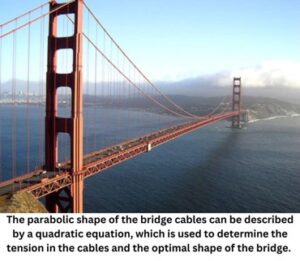Introduction
- Have you ever wondered how bridges can withstand the forces of nature and remain standing for years, even decades?
- How do economists determine the optimal level of production or sales that will maximize profits?
The answer lies in quadratic equations, a fundamental mathematical concept with many applications in science, engineering, and economics.
In this blog post, we’ll explore the following concepts of quadratic equations –
- Quadratic Equations and Their Types
- Solving quadratic equations using various method
- Factoring Method
- Completing the square
- The quadratic formula (Shridharacharya’s rule)
- Discriminant of the quadratic equations
- Roots of the quadratic equations
- Complex numbers & Quadratic Equations
- Nature of the roots of the quadratic equations
- Application of Quadratic Equations
- Conclusion
So, buckle up and let’s dive into the exciting world of quadratic equations!
Quadratic Equations and Their Types
A quadratic equation is a second-degree equation in one variable. The highest degree of its variable is 2. The general form of a quadratic equation is
![]()
where a,b and c are numbers (real or complex), a is not equal to zero, and x is the variable.
There are two types of quadratic equations-
- Pure quadratic equations: This type of quadratic equation contains only square terms.
For example:
![]()
- Quadratic equations with linear terms: This type of quadratic equation contains square as well as linear terms in the equation.
For example:
![]()
Solving quadratic equations using various method
Solving a quadratic equation means finding the values of its variable which satisfy the equation. These values are called roots of the equations. There are various ways to solve a quadratic equation, such as factoring, completing the square and using the quadratic formula. We will study each method in detail as follows-
1. Factoring method:
In this method, we factor the quadratic equation into two binomial expressions and then set each expression equal to zero. After doing this, we can easily find out the values of variables and the equation is solved.
These methods are often helpful in AP Precalculus or Precalculus honors.
Consider a quadratic equation
![]()
Now we will factorize it.
![]()
![]()
![]()
![]()
Hence the required values of the x will be x=-1 and
![]()
These two values of x are the solutions of the given quadratic equation.
2. Completing the square:
In this method, we add or subtract a constant to both sides of the equation to create a perfect square trinomial (The expanded form of a perfect square).
For example: Solve
![]()
To make the perfect square, we have to add
![]()
both sides then
![]()
![]()
![]()
![]()
![]()
and
![]()
These two values of x are the solutions of given quadratic equation. This method is often helpful to find vertex of Quadratic equation – favorite of SAT!
3. The quadratic formula (Shridharacharya’s rule)
In this method, we compare the given equation with the general form of a quadratic equation that is
![]()
Then we write down the values of a, b and c.
Here we have a quadratic formula which is called sridharacharya’s rule-
![]()
This expression shows the solutions of equation
![]()
Now we put the given values of a, b and c in the quadratic formula and in this way, the equation is solved.
For example: Solve
![]()
On comparing it with
![]()
, we come to know that
![]()
and
![]()
Now,
![]()
![]()
![]()
Where
![]()
is an imaginary number.
Hence,
![]()
are the solutions of the given equation.
Algebra course will test you on this method.
Discriminant of a Quadratic Equation
The term
![]()
in the quadratic formula of
![]()
under the square root is called the discriminant D of the Quadratic Equation.
So,
![]()
Then the quadratic formula in terms of discriminant can be written as –
![]()
For example: find the discriminant of
![]()
Here
![]()
and
![]()
And its discriminant is 65.
Roots of a Quadratic Equation
The roots of a quadratic equation are the values of x that satisfy the equation. In other words, they are the values of x that make the quadratic equation true. A quadratic equation has three types of roots: real, complex, and equal.
Complex numbers & Quadratic Equations
Complex numbers and quadratic equations are closely related, as quadratic equations can have complex number solutions. This section will explore the connection between complex numbers and quadratic equations in more detail.
Firstly, it is essential to understand what complex numbers are. A complex number is a number that can be expressed in the form a+bi, where a and b are real numbers, and i is the imaginary unit, which is defined as the square root of -1. For example, 3+2i is a complex number, where a=3 and b=2.
Now, let’s consider the general form of a quadratic equation:
![]()
If the discriminant,
![]()
, is negative, then the roots of the quadratic equation will be complex numbers. This is because the square root of a negative number is an imaginary number.
For example, the quadratic equation
![]()
has no real solutions, as the discriminant is -16. The roots of the equation are complex numbers:
![]()
![]()
Using the quadratic formula, we can also express the roots of a quadratic equation with complex numbers. For example, the quadratic equation
![]()
has roots:
![]()
![]()
![]()
It is worth noting that if the coefficients of a quadratic equation are also complex numbers, we can still use the quadratic formula to find the roots. For example, consider the equation:
![]()
Using the quadratic formula, we can find the roots:
![]()
![]()
Thus, we have shown that complex numbers and quadratic equations are intimately linked. The presence of complex numbers allows us to find solutions to quadratic equations that would otherwise have no real solutions.
Nature of the Roots of the Quadratic Equations
The nature of the roots of a quadratic equation is determined by the discriminant, which is given by the expression
![]()
.
The discriminant provides us with information about the equation’s type of roots.
- When the discriminant is positive
![Rendered by QuickLaTeX.com \[(b^2-4ac > 0)\]](data:image/svg+xml;base64,PHN2ZyB4bWxucz0iaHR0cDovL3d3dy53My5vcmcvMjAwMC9zdmciIHdpZHRoPSIxMDgiIGhlaWdodD0iMjIiIHZpZXdCb3g9IjAgMCAxMDggMjIiPjxyZWN0IHdpZHRoPSIxMDAlIiBoZWlnaHQ9IjEwMCUiIHN0eWxlPSJmaWxsOiNjZmQ0ZGI7ZmlsbC1vcGFjaXR5OiAwLjE7Ii8+PC9zdmc+)
, the equation has two distinct real roots.
For example, consider the equation
![]()
. Here,
![]()
and
![]()
. The discriminant is given by
![]()
. Since the discriminant is positive, the equation has two distinct real roots. We can solve the equation by factoring it as
![]()
, which gives us the roots
![]()
and
![]()
.
2. When the discriminant is zero
![]()
, the equation has one real root of multiplicity 2.
For example, consider the equation
![]()
. Here,
![]()
and
![]()
. The discriminant is given by
![]()
. Since the discriminant is zero, the equation has one real root of multiplicity 2. We can solve the equation by factoring it as
![]()
, which gives us the root
![]()
.
3. When the discriminant is negative
![]()
, the equation has two complex conjugate roots.
For example, consider the equation
![]()
. Here,
![]()
and
![]()
. The discriminant is given by
![]()
. Since the discriminant is negative, the equation has two complex conjugate roots. We can solve the equation using the quadratic formula as
![]()
. Substituting the values of
![]()
and
![]()
we get
![]()
or
![]()
. Therefore, the roots of the equation are
![]()
and
![]()
.
Note:- In fact, complex roots of an equation with real coefficients always occur in conjugate pairs like 2 + 3i and 2-3i. However, this may not be true in the case of equations with complex coefficients. For example,
![]()
has both roots equal to i.
Application of Quadratic Equations
Physics:

Quadratic equations solve physics-related problems related to motion, gravity, energy, and more. For example, the equations of motion, such as the distance travelled by an object under constant acceleration, can be modelled using quadratic equations.
Engineering:

Engineers use quadratic equations in various applications, including the design and optimization of structures, materials, and systems. For example, in civil engineering, the parabolic shape of suspension bridges can be modelled using quadratic equations.
Music:

Quadratic equations can be used in music to create complex waveforms and harmonics. For example, the frequency of a vibrating string or a musical instrument can be modelled using quadratic equations.
Conclusion:
Quadratic equations are a fundamental part of mathematics and have numerous applications in various fields. They are used to model real-life situations and solve complex problems in physics, engineering, business, computer graphics, music, medicine, sports, and many other fields. The formula to solve quadratic equations is simple, yet the implications and applications of this formula are vast and diverse. Understanding and mastering quadratic equations can lead to a deeper appreciation of mathematics and its applications in the real world. Whether you are a student, an engineer, a business owner, or a scientist, knowing how to use quadratic equations can be a valuable skill that can help you solve problems and make informed decisions.
Are you planning to take AP Precalculus? Checkout Everything You Need to Know About AP Precalculus



